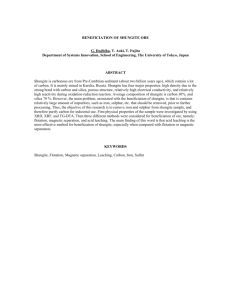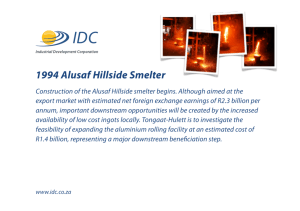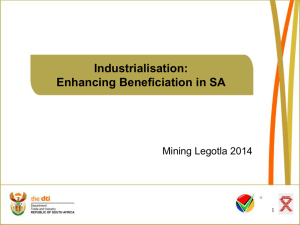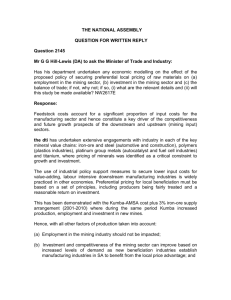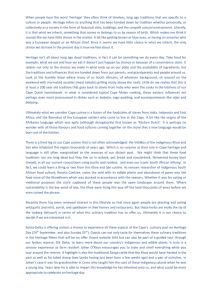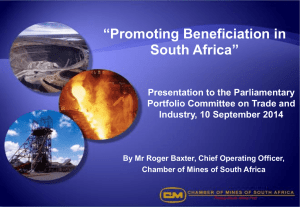Lingela CSIR CPSI Conference
advertisement
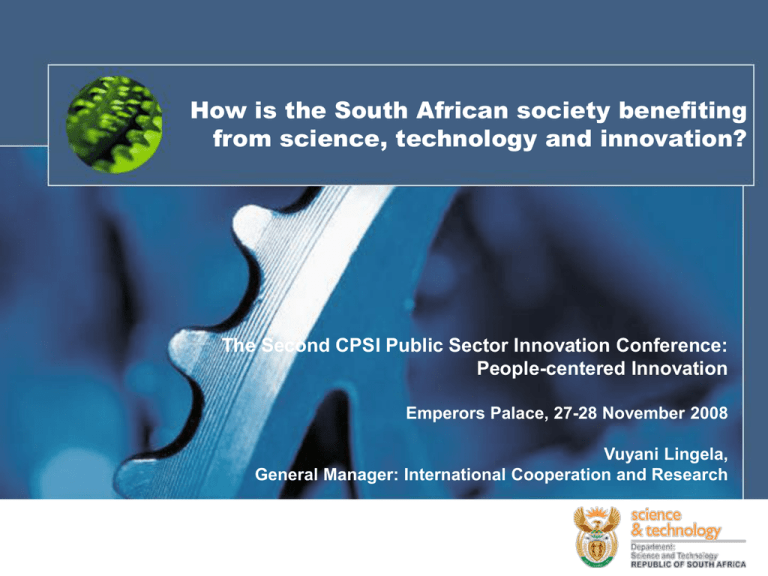
How is the South African society benefiting from science, technology and innovation? The Second CPSI Public Sector Innovation Conference: People-centered Innovation Emperors Palace, 27-28 November 2008 Vuyani Lingela, General Manager: International Cooperation and Research 1 Contents 2 1. What is the relationship between science, technology and innovation and economic development? 2. How are the South African innovation actors contributing to national competitiveness through science, technology and innovation? 3. How are the South African innovation actors contributing to poverty alleviation and employment creation through science, technology and innovation? National Competitiveness Wealth Creation Quality of life • Technology based growth • Technology Achievement Index S&T Human Capital • Researchers in workforce • Demographics of SET workforce Future R&D capacity 3 Technical progress (Improvement and Innovation) • Patents • Business R&D intensity • ICT uptake indicators Current R&D Capacity • Share of publications • R&D intensity (investment) • University enrolments • S&T post-graduate degrees • University entrance in Maths and Science Business performance • Technology/ trade mix • Key sector performance • New sectors (e.g. biotech) Imported know-how • Technology balance of payments Innovation Management ACTIVITIES Business Development Research & Development Human Resource Development INNOVATION MANAGEMENT Financial Institutions Research Institutions Industry Education Institutions Government ACTORS Source: Lingela, Buys and Shimozawa (2007) 4 Economic Development What is the relationship between science, technology and innovation and economic development? Real world examples? 5 Economic & Scientific Wealth Source: DA King, Nature 430 (2004) 311 (15 July 2004) 6 Africa’s exports to the world 60.0 ? 40.0 20.0 0.0 2000 Yr Source: The World Bank Group (2004) 7 EU US Asia 52.2 19.1 16.4 Major importers of SA passenger cars 20.0 10.0 0.0 2000-02 Yr Germany Japan UK US 20.9 17.4 17.2 11.7 Source: The World Bank Group (2004) 8 Australia Namibia 10.4 8.1 Africa’s exports to Asia 40.0 30.0 20.0 10.0 0.0 2001 Yr South Africa Angola Nigeria Egypt Zimbabwe Zambia 37.8 9.9 8.0 3.0 1.7 1.1 Source: The World Bank Group (2004) 9 Goods exported to Asia South Africa Zambia Zimbabwe Liberia Platinum Pulpw ood Iron Ore Coal Aluminum Gold Ferro-alloys Diamonds Copper Ships, boats Crustacean 0 10 Source: The World Bank Group (2004) 10 20 30 40 50 60 70 80 90 100 Goods exported to Asia Japan Korea China India Ships, boats Diamonds Pulpw ood Platinum Crustacean Ferro-alloys Iron Ore Aluminum Coal Copper Gold 0 11 10 20 30 40 50 60 70 80 90 100 Source: The World Bank Group (2004) Goods exported to Africa Japan Korea China India Piston engines Machinery (constr & mining) Motor vehicle parts Passenger cars Tires Motor vehicles Telecom parts Fabrics, textiles 0 Source: The World Bank Group (2004) 12 10 20 30 40 50 60 70 80 90 100 Goods exported to Africa South Africa Egypt Zimbabwe Kenya Piston engines Motor vehicle parts Fabrics, textiles Telecom parts Passenger cars Motor vehicles The World Bank Group (2004) Tires Source: The World Bank Group (2004) 0 13 10 20 30 40 50 60 70 80 90 100 Export & import of Africa’s cut flower 60.0 40.0 20.0 0.0 Exports, 2000-02 Yr Imports, 2000-02 Yr Source: The World Bank Group (2004) 14 Kenya Zimbabwe South Africa 50.9 19.9 9.5 Netherlands Japan 61.8 2.1 Major recipients of Japanese FDI 80 60 40 20 0 1991-2002 Yr Liberia South Africa Tanzania Mauritius Egypt 74.9 18.2 2.7 1.1 0.9 Source: The World Bank Group (2004) 15 Japanese investments in Africa 100 75 50 25 0 1971-80 1981-90 1991-02 Manufacturing 5.3 3.1 20.2 Non-Manufacturing 94.5 96.9 79.7 Mining (30.5%) Transportation (56.6%) Source: The World Bank Group (2004) 16 Mining (1.2%) Transportation (67.4%) Major recipients of Korean FDI •Hotels and restaurants •Manufacturing •Trade and retail 40.0 20.0 0.0 1968-2002 Yr Algeria Sudan South Africa Morocco Nigeria 41.7 28.8 14.8 10.3 4.4 Source: The World Bank Group (2004) 17 Major recipients of Chinese FDI •Manufacturing •Resource development 20.0 10.0 0.0 2001 Yr Zambia South Africa Mali Tanzania Zimbabwe 18.5 15.3 8.0 5.4 4.6 Source: The World Bank Group (2004) 18 National competitiveness How are the South African innovation actors contributing to national competitiveness through science, technology and innovation? 19 Joule: Africa’s first battery electric car Source: Optimal Energy (Pty) Ltd (2008) 20 Joule: Africa’s first battery electric car 1. An investment from the Innovation Fund, an agency of the DST, made this venture possible. 2. The current shareholders in Optimal Energy comprise executive management, the Innovation Fund and the Industrial Development Corporation (IDC) of South Africa. Source: Optimal Energy (Pty) Ltd (2008) 21 Ravin 500: Advanced piston engine for general aviation aircraft Source: ADEPT Airmotive (2008) 22 Ravin 500: Advanced piston engine for general aviation aircraft 1. What is probably the most advanced piston engine for general aviation aircraft in the world today has been developed by Adept Airmotive in South Africa. 2. Funding was obtained from Tanglewood Private Equity. Subsequently, a grant for R13,5-million over three years was obtained from the Innovation Fund (IF) ), an agency of the DST. 3. The company has also benefited from the Technology Stations Programme (A Programme of the DST, GTZ and HESA): – Composites Technology Station at the Durban University of Technology and – Rapid Prototyping and Manufacturing Technology Station at the Central University of Technology. Source: Engineering News (2007, 30 November) 23 Johanna Solar Technology Source: Johanna Solar Technology GmbH (2008) 24 Johanna Solar Technology 1. Helped with funding from the Innovation Fund, an agency of the DST, Prof Vivian Alberts and his Team at the University of Johannesburg have brought the so-called CIGSSe (copper, indium, gallium, sulphur and selenium) thin film technology to a marketable state over 13 years of development work. 2. Johanna Solar Technology GmbH acquired the licence in August 2005, and the company is now building the world's largest production site for siliconfree thin film solar modules based on this CIGSSe technology at Brandenburg an der Havel. 3. Johanna Solar Technology GmbH has granted a first license to the Chinese company Shandong Sunvim Solar Technology Co. Ltd. for the construction of a thin film solar module production plant. Source: Johanna Solar Technology GmbH (2008, 10 March) 25 Poverty alleviation and employment creation How are the South African innovation actors contributing to poverty alleviation and employment creation through science, technology and innovation? 26 Poverty alleviation and employment creation Prof. Simphiwe Mini General Manager: Technology for Social Impact Mr. Lucky P. Khumalo Manager: Monitoring & Coordination Tel: +27 12 317 4449/4499 Fax: +28 86 681 0040 E-mail: Lucky.Khumalo@dst.gov.za 27 DST Technology for Social Impact 1. Funding of initiatives with social impact 2. Funding initiatives that will grow into sustainable businesses 3. Technology Sourcing and Transfer – Source skills, knowledge, and equipment from the NSI – Provide partnership with other Government Departments 4. Collaboration with Local Players – Government – Communities 5. Integrated Manufacturing Strategy (IMS) through the DTI 28 DST Technology for Social Impact 6. Focus on Post-Harvest Agro-processing (beneficiation, value-addition) technologies. 7. Sources of technologies & skills • Science Councils (CSIR, ARC, MRC, MINTEK, HSRC, etc) • Higher Education Institutions (Universities & Colleges, etc) • Private Sector • Government Departments • NGO’s and Innovators 8. Establish viable community-owned businesses where skills & technology transfer has occurred. 9. Projects as early as 2000/1 – current 10. Thirty nine (39) project types almost 200 sites in the country. 29 DST Technology for Social Impact: Projects 2000 - 2005 30 Strategic Areas of Collaboration 1. Agriculture – Post-harvest Agro-processing Technologies – High-value agro-commodities • Essential oils • Indigenous Natural Products • Aquaculture (fresh water cage-net fish farming) – Beneficiation of organic Materials (fibres, leathers, etc) 2. Health – Primary Health – Technologies for Processing Medicinal Plants – Sanitation / Environmental Health 31 Strategic Areas of Collaboration 3. Energy – Technologies that conserve fossil fuels – Alternative Energy Sources – Non-fossil fuels 4. Small Scale Mining – Mineral processing and beneficiation (Jewellery) 5. ICT (Information & Communication Technologies) 32 Beneficiation (Processing) Technologies • 33 Food Processing Technologies – Indigenous Foods Processing – Cashew Apple Processing – Fermented Milk Products – Fermented Indigenous Beverages – Beekeeping (farming) – Oyster Mushrooms Propagation – Aqua-culture (Small-scale fish farming) • Herbs Beneficiation & Oils extraction – Indigenous Medicinal Plants (MRC, ARC, INR & CSIR) – Essential Oils (Aroma therapeutic) Oils • Animal Fibre Beneficiation – Cashmere Beneficiation – Mohair Beneficiation – Wool Beneficiation – Leather* Beneficiation Beneficiation (Processing) Technologies • Plant (Leaf) Fibre Beneficiation – Sisal Beneficiation – Hemp Beneficiation – Hand Paper-Making – Indigenous Grass Weaving & Furniture Making • Small-Scale Mining – Jewellery Making (Mineral Beneficiation) – Pottery (Clay Beneficiation) 34 Technologies for Beekeeping 35 Technologies For Bee Farming 1. Transfers bee farming (apiary) technology & skills to communities to extract organic honey, & develop secondary wax & pollen products. 2. Establish businesses based on beekeeping and associated crafts among historically disadvantaged and resource poor communities. 3. Equips aspirant beekeepers with adequate equipment and business skill training to manage successful bee farming businesses - over 600 people have been trained in beekeeping. 4. Trademark, INYOSI HONEY™. Website, http://www.inyosi.co.za/ 5. Awarded Platinum Award by the Impumelelo Innovations Trust in 2002. 36 Indigenous Food Processing Technologies (Indigenous Foods, Cashew Apple & Fermented Milk Products) 37 Food Processing Technologies (Indigenous Foods, Cashew Apple & Fermented Milk Products) 1. 38 Transfers Food Processing technologies to communities and establish sustainable SMME’s – Indigenous Foods • Processing and Packaging of Indigenous Foods • Provincial processing centres established and equipped • Section 21, Indiza Foods registered • Recipe Book on Indigenous Foods – Cashew Apple • Processing of Cashew Apple into juice & dried fruits • Processing factory in KwaNgwanase (KZN) • Products being market tested – Fermented Milk Products • Yoghurt factory in Mangaung (Free State) • Products already in supermarket shelf – To be incorporated under Indiza Foods® 2005/6 Animal Fibre Beneficiation 39 Animal Fibre Beneficiation (Cashmere, Mohair, Wool) 1. Transfer animal fibre beneficiation and processing technologies to resource-poor farmers 2. Transfer livestock improvement & cross breeding tech 3. Establish animal fibre-based SMME’s – Livestock improvement successful – Cashmere Knitting SMME’s in Maluti (EC) & Klipkuil (NW) • Cashmere products in varied designs • SMME’s registering as businesses – Two Mohair-based weaving groups in E. Cape • Produce mohair blankets, – Wool farming in Mpumalanga & E. Cape • Shearing & Classing • Felting & Knitting SMME’s established – Products Accredited Proudly South African® – Products featured in various exhibitions & international fairs. 40 Oyster Mushrooms Propagation 41 Oyster Mushroom Propagation 1. Transfer Oyster Mushroom propagation technologies to communities as an alternative to small gardens and source of proteins. 2. Cheap technology – Organic Farm Waste (wheat straw; grass; cobs) to high value mushrooms in 30 days. – Expanded to all provinces already – Some groups already selling to local super – markets, guest houses and communities – Establishing a Section 21 Company (Amakhowa) – Increased interest from communities 3. DST expanding to most rural areas in 2004/5 – 33 sites established throughout SA 42 Leather Beneficiation 43 Leather Beneficiation 1. Transfer hides and skin (labour-intensive) tanning technologies to communities 2. Manufacture leather goods for market – Directed to source leather from existing tanneries – Leather products already being produced in KZN, NW & WC. • W. Cape: High quality Ostrich leather products (Beaufort West) • W. Cape: High quality Karoo pelt products (Laingsburg) – Working with Woodheads Pty Ltd in Products dev. & Marketing • Operational Buildings completed in North West (Supingstadt & Lekgopung) • KZN: Renting space and already making products (uBombo) 3. Expanded to W. Cape to process the Karoo pelt. 44 Plant Fibre Beneficiation (NgeZandla-Zethu, Manguzi) 45 Plant Fibre Beneficiation (Hemp, Sisal, Incema, Isikhonko) 1. Use fibre rich high-value cash crops as an alternative to subsistence to emerging farmers. – Hemp Cultivation in E.Cape (Under license) • to produce hemp fabric and other products. • Six tractors bought for farming operations – Sisal revitalization programme (N.West) • Material components for the Automotive Sector • Developed decortications (fibre-extraction) equipment – Incema & Isikhonko • Indigenous Grasses in KZN used in furniture making • Twine weaving & various craft products • Equipment over R120 000 in 2003/4 • Registered as a Company - Turnover ±R35 000/month 46 Hand Paper Making KZN Papermaking & Craft Packaging (Eshowe – KZN) 47 Hand Paper Making 1. Source & transfer fibre extraction & pulping technologies to manufacture paper by hand and to produce high quality products from the paper. 48 • Gauteng, KZN, E. Cape, NW, W. Cape, Free State, Limpopo • Established successful groups in KZN & W. Cape – KZN Papermaking & Craft Packaging (Eshowe – KZN) – Kuyasa Paper product (Kommetjie – W. Cape) – Siyazama Group (Khayelitsha – W. Cape) • Total of 20 enterprises formed • Phumani Paper registered as Section 21 Company • Registered as accredited training provider of training in hand paper making • NQF Level 2 Learnership from Create SA (MAPP SETA) Essential Oils Herbs Propagation 49 Essential Oils Processing 1. Transfers essential oils propagation and distillation technology & equipment. 2. Four, successful essential oils businesses have been established and are based in – Giyani (Limpopo); Driekoppies (near Nelspruit in Mpumalanga), – Badplaas (Mpumalanga); and Pacaltsdorp (near George in the Western Cape). 3. Each site has been equipped with a steam distillation factory worth more than R850 000 with a maximum capacity of handling more than 100ha of herbs. 4. Registering groups as companies, and providing focused business mentorship and management. 50 Indigenous Medicinal Plants (Herbs) (Bio-Prospecting) 51 Indigenous Medicinal Plants (Natural Products) 1. MRC identified 7 indigenous herbs with immune modulating properties (clinically-proven) for HIV/AIDS sufferers – Transfers herbs propagation technologies to communities • N. Cape, N. West, E. Cape, Limpopo & Mpumalanga – Value-addition of herbs into capsules and other medicines – Establish a processing factory – Collaboration with other pharmaceutical companies 2. Devils Claw Processing (N. West) – ARC – Process into dried materials and later tonic & capsules. 3. New Activities – Anti Asthma (BP4) – Anti-Obesity (San IKS) 52 Hi Hanyile Mosquito Repellent 53 Mosquito Repellent 1. Mosquito Repellent (CSIR) Musuzwana (Lippia) – An indigenous plant (BP1) is propagated commercially – Introduced technology to extract the properties, clinical trials (CSIR & SABS) shows that it has a high efficacy than commercial mosquito repellents; – Introduced oil extraction technologies, and produce mosquito repelling candles – A Factory has been completed in Hi Hanyile, Giyani and is soon to be launched (June 2005) – Partnership with commercial partners, Parks Boards and Environmental Affairs 54 Glass Beads Manufacturing 55 Glass Beads Manufacturing 1. Aims at promoting indigenous (African beadwork) jewellery design technologies. 2. Transfer jewellery making technologies to use glass to manufacture ethnic looking glass beads 3. Establish an ethnic jewellery SMME – Group of women in N. Cape (O’ Kiep) – Provided training & equipment – Selling jewellery in Cape Town – Additional training & product diversification provided. 56 Small-Scale Mining & Beneficiation 57 Small-Scale Mining & Beneficiation 1. Transfer pottery (clay beneficiation) technologies to communities to improve the quality of their Clay pots – Ndwedwe in KZN (MINTEK) 2. Transfer stone carving technologies to communities to value-add these into high value ornaments – Limpopo, Northern Cape (MINTEK) 3. Use plant fibre to strengthen ornamental pots – Eshowe KZN (with Univ of Johannesburg) 58 Aquaculture 59 Aquaculture 1. Transfer fresh water fish farming (cage nets) to rural communities using irrigation dams and schemes. 2. Established sites in the Western Cape – Franschhoek area 3. Expanding to KwaZulu-Natal – Makhathini Flats Irrigation Scheme 4. Feasibility Studies in 5 Provinces – Eastern Cape; Northern Cape; North West; Mpumalanga; Limpopo 5. Partnership with Univ of Stellenbosch & ARC 60 THANK YOU Vuyani Lingela, General Manager: International Cooperation and Research DST Tel: +27 (0)12 843 6517, Cell: +27 (0)82 600 4722, Fax: +27 (0)86 681 0051 Postal Address: Private Bag X 894, Pretoria 0001, South Africa Physical Address: Building 53, Meiring Naude Road, CSIR Campus, Pretoria 0184, South Africa 61
